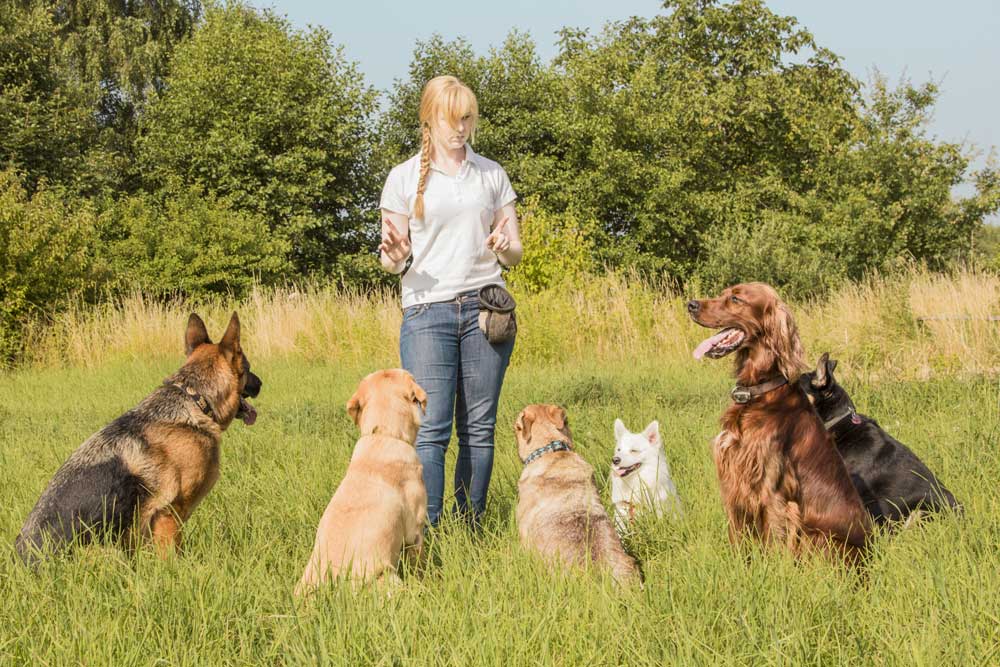It’s imperative to get off on the right paw when teaching your new puppy how to properly behave, whether it be how to teach a dog loose leash walking, dog command hand signals or just teaching your dog how to sit and stay. These commands are important to building a foundation of trust and obedience with your new pup so they are a well behaved dog for years to come. When working on how to train a puppy basic commands it’s important to base it off positive reinforcement and to show the pup that when doing something good or bad they will rewarded or disciplined. The first few months of your puppy’s life and how you train them are essential to how they will behave and act for years to come. Here we will look at how to train a puppy basic commands and how to do it the most efficient way possible.
How to Get Started
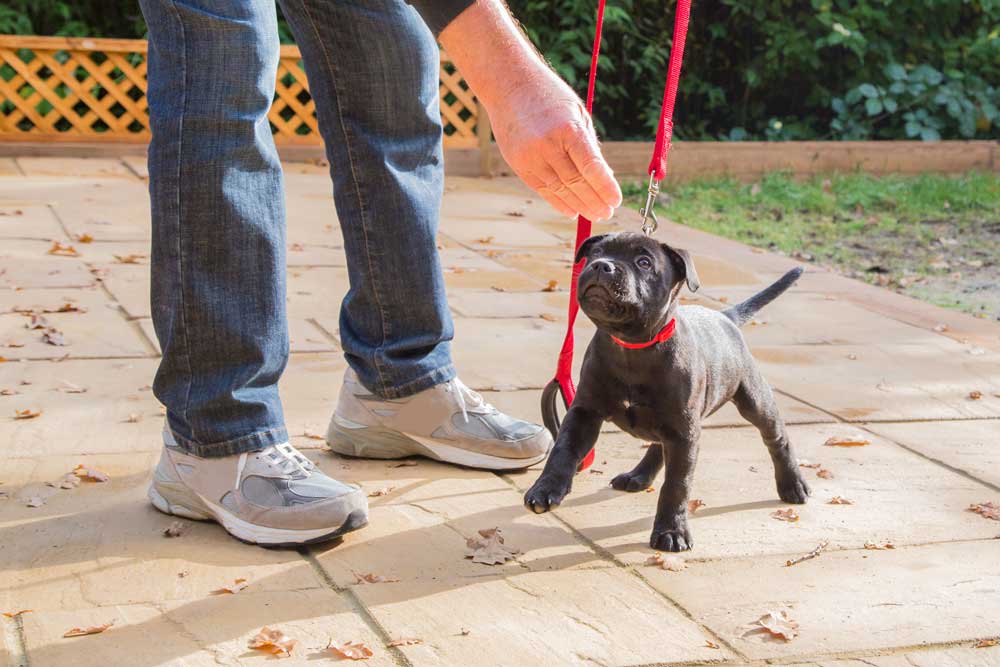
Appropriate training of your puppy is highly important in the early stages of their life, with both training and socialization being the most important aspects of your pups young life. Training a puppy isn’t a walk in the park… it can be tiring and at times overwhelming, this is especially true if it is your first dog you’ve owned. Taking it one step at a time is the best way to approach educating your puppy and will help ease the stress that comes with training a puppy.
Getting started right away is key in the development of skills your puppy learns. Specific light training exercises like potty training and household ground rules should be your starting point, rules such as where your puppy sleeps, certain areas they are allowed in and couch training are all perfect examples of light training. These should be taught within the first few months and to not get overly complicated, as the puppy develops so does their mind, as the months go on your puppy’s attention span should get better. This will lead you into teaching them the more basic commands, gradually moving towards the more advanced commands.
It’s important to use the power of positive reinforcement when training your pup how to be a well behaved dog. Positive reinforcement is when you reward a positive action with a form of a reward, it’s all about encouraging good behavior. It’s important not to look at this as you are bribing your pup to be good, but to train your dog using something it wants and values, like a dog treat. When using positive reinforcement you can use something your pup likes, more often then not people use a form of a treat. Dogs love to be loved and they must be taught properly to enjoy praise. Puppies are babies and it’s important to remember that, we can’t expect dogs understand things that they don’t know of yet, just like you wouldn’t with a small child. Remaining patient goes a long way with training your puppy and will only help make the training process that much easier.
Now that we have a better understanding of how to approach training your puppy, let’s take a look on how to train a puppy basic commands.
How to Teach a Dog to Sit
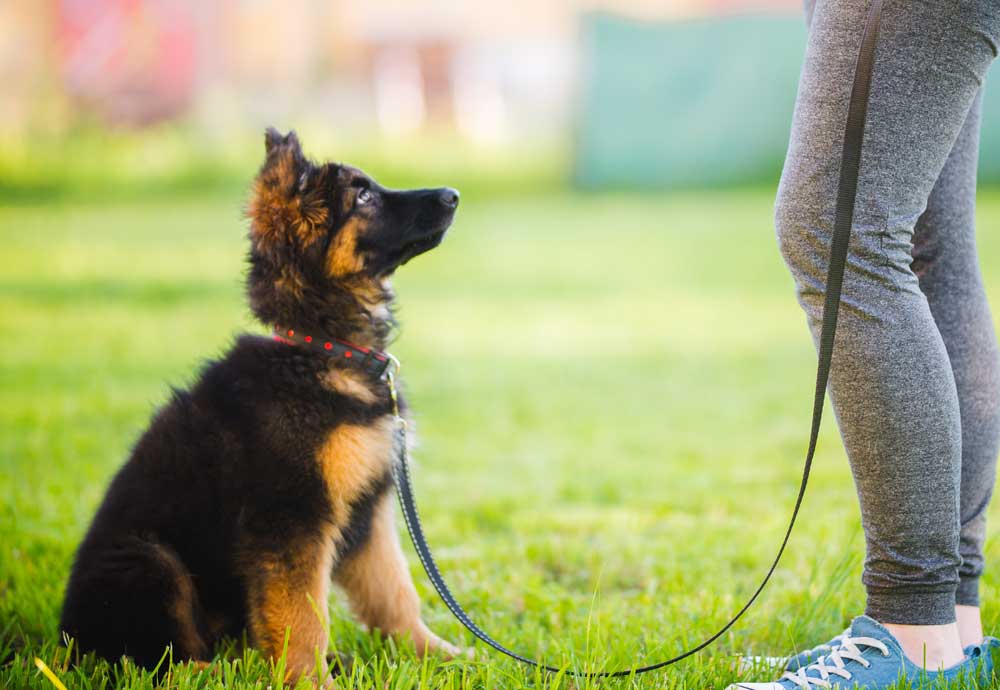
Teaching a puppy how to sit is usually the first command most people teach their puppy. It allows for the owner to assert an element of control when doing things like crossing the street with cars driving by, it’s an important command that should be one of the first you teach your puppy. It can also begin the ground work for other commands like teaching them to stay. It’s all about helping your puppy understand the word with the action. As we mentioned above you should have some sort of treat when teaching a dog to sit, these training treats should be soft small and something your puppy is always after.
First thing when teaching a dog to sit is to make sure when they do sit that there behind is firmly planted on the ground, some dogs will hover without actually sitting down or even sit down but on to one side. When beginning this exercise first start off with showing your dog the treat in your hand. Make sure to hold the treat just above the dogs nose (not too high or they may jump up) then move it above their head, they will begin to move backwards, this will force the dog to begin to back up and automatically put them in a position where they feel they need to sit down. This is a useful dog command hand signal that can be used in various teachings. Once your pups butt hits the ground it’s imperative to be positive by saying “yes” or “good boy/girl”, then while remaining positive give your dog a treat, followed by more positive reinforcement like petting or praising. Now repeat these steps until your dog sits at the sight of the treat above its nose, this should take about 10 or so attempts. When your puppy starts to show that it understands the treat over the nose means to sit down then it’s time to insert the word “sit” to the process. When holding the treat over the dogs nose say the dogs name followed by the word “sit”. Repeat this task several times until you no longer need to move the treat from the nose to the back of the head, keep the treat just remove the hand motion.
Continue this technique several times during the day in various locations in your house and outside. You want to bring your dog into a situation where there is distractions so they can become more disciplined when it comes to paying attention. Continue this training until your dog sits on voice command without the treat.
Teaching a Dog to Stay
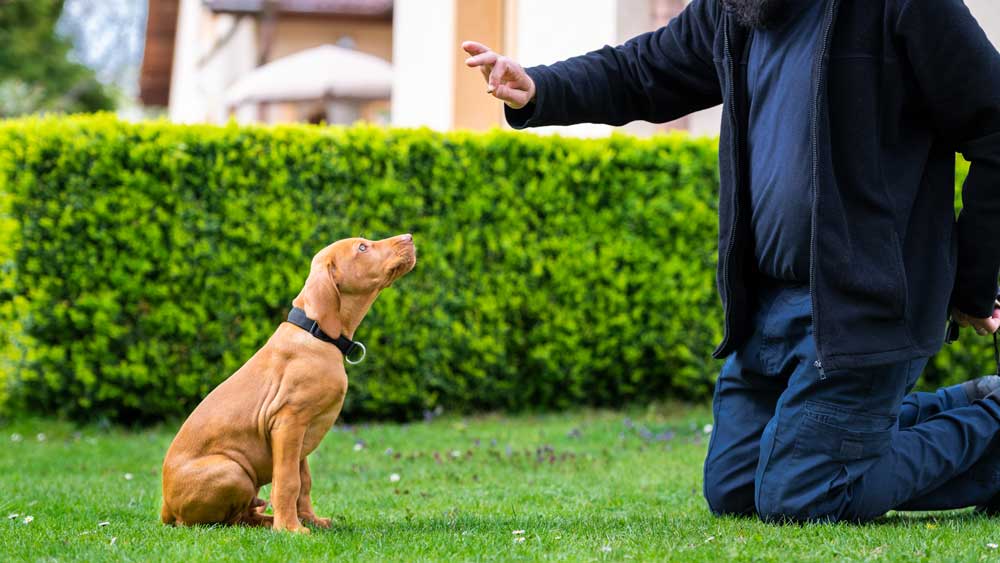
When teaching a dog to stay there are various ways, but to be effective the key is to teach your dog it is more rewarding to stay put then to break a position. Similar steps from teaching a dog to sit can be applied to teaching a dog to stay, with just a few added variables into the mix.
One of the biggest mistakes that people run into when teaching their dog to stay is that they teach their dog to break that position rather then hold it, for example, if you ask your dog to “stay” walk away and call it to you, you’re actually teaching him to break the position you just asked him to hold. To start you should kneel down and hold the puppy by the collar, place your dog treat in your hand and hold it at arms reach away in front of your dog. They will most likely pull and try to get the treat, make sure to wait patiently, if they hold the position then make sure to praise them, the more the dog pulls the longer you should make them wait. Be patient, and keep it short and sweet, when you release the dog say “ok” and give them the reward. You may need to do a few repetitions before moving on. The dog will begin to connect the behavior of staying with the reward. They will find it is more rewarding to hold still than to try to get the reward himself. Next stand up and hold the dogs leash close to your body then place the treat about two feet away from you and the dog, your dog may react and pull on the least but hold tight and keep them to your side. Then go and get the reward and bring it back to the dog, when you leave to retrieve the reward, some dogs will pull and get excited when you touch the reward, be prepared to wait again or drop the reward and wait longer. When the dog is clam release the dog and say the word “OK” then give them the reward. Next is to repeat the last part but this time when you throw the treat further ahead while holding the dog, you should walk to retrieve the object, leaving your dog behind. While walking away praise the dog for staying put and bring the reward back, then release the dog and give them the treat. The main purpose of these steps is encouragement, your pup should be learning to stay put because it’s interactive and rewarding. Practice these steps, with each day adding more and more time to the length of the “stay“ command. It is all about teaching your dog patience, your pup will learn that patience gets them the reward faster if they stay calm rather then trying to pull or run to the reward.
How to Teach a Dog Loose Leash Walking
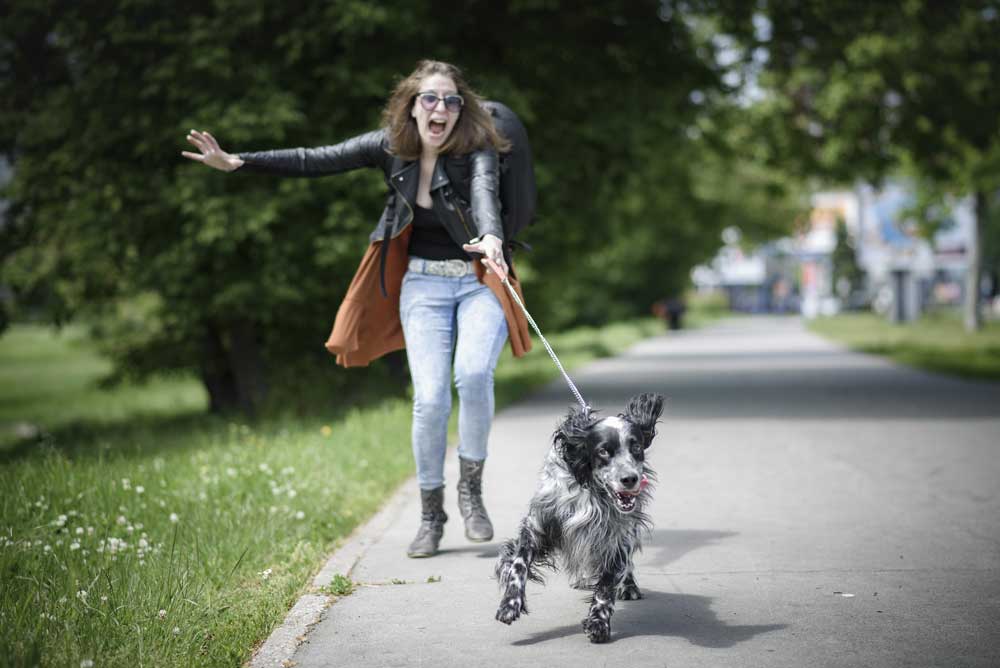
Dogs are excitable by nature, they want to meet everyone, sniff everything and run through anything. There is nothing worse though when a dog gets these urges and you’re on the end of a leash holding them back. As you hold on for dear life you may ask yourself, who is walking who here? This is why so many dog owners are learning how to teach a dog loose leash walking while they are still puppies. If taught properly your pup will grow up to be an obedient walker and a more disciplined dog in general. The step you want to take it make sure you are in an environment that is free of distractions and other dogs. When you start to train your pup loose leash walking you should keep the length of your training walks short to start with, it’s hard for a dog to focus during a long walk full of distractions. It’s even been recommended that you play with the dog beforehand to help get rid of that excess energy. The first step is very very straight forward, when your pup starts to pull on the leash, you stop walking. Simple eh? Once the dog realizes it’s not going anywhere it will stop, this is where you ask your dog to come back and sit beside you. Once the dog has sat beside you, you can say a positive word and give them a small treat. Start your walk up again, if they stick beside you then continue to use that positive word while giving them a treat ever so often. If they begin to wonder and pull on the leash, repeat the step above. Your pup is likely going to want to sniff anything and everything which is totally normal and fine for a dog, but when training them for a loose leash, it needs to be approached a littler differently. If your pup goes to pull on the leash while trying to smell or inspect something, stop walking and call them back. When they come back have them sit beside you, but this time don’t give them a treat, instead walk to the item they are interested in after having them sit beside you. This leads them to believe that the object or item they wanted to inspect is actually the reward for sticking close by.
Continue practicing this for a week weeks on a shorter less busy route, once you feel your pup is learning the ways of the loose leash walking then try it out in a busier area. Continue these steps and we guarantee your dog will be casually walking beside you with no pulling in a short couple of weeks.
Dog Command Hand Signals
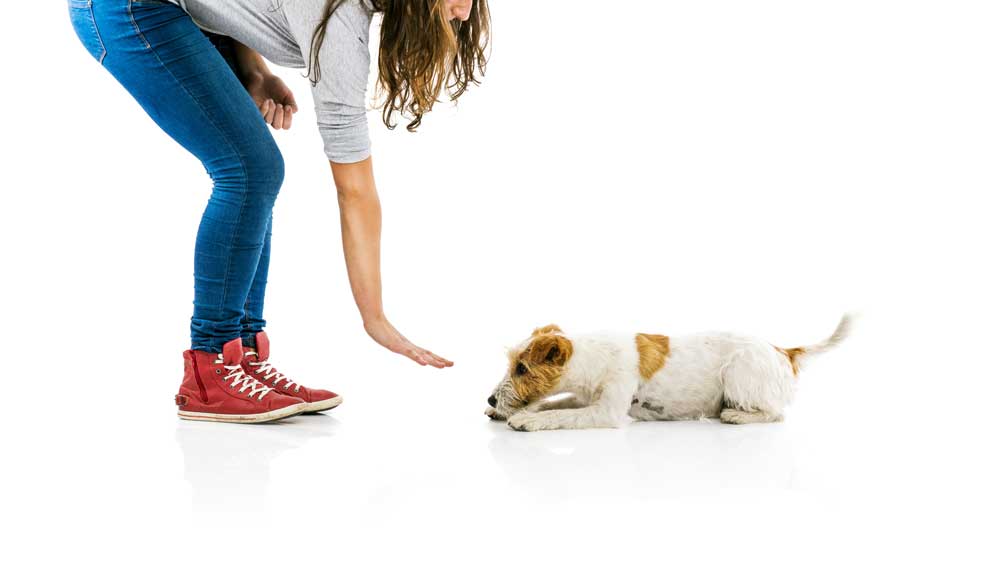
Most of the time we expect our dog to understand out commands through verbal communications, but using dog command hand signals can be as, if not more effective then verbal commands. Some pets may struggle with understanding verbal commands and other dogs as they get older lose some of their hearing, this is where hand signals come in handy. Let’s have a look at a few hand signals you can teach you dog.
Open Hand Palm Up- This is the most common command hand signals. It’s quite simple, you face you palm up towards the sky, you then move your open palm towards your chest in a upwards motion. When doing this command make sure to also associate it with the word sit while doing the hand signal.
Find Point Down- Telling your dog to lie down can come in handy, especially when they are being too energetic. To preform this action you hold you finger point up at your chest, then move your finger in a diagonal motion downward. Your dog should soon understand that pointing downward that it means lie down.
Open Hand Palm Forward- Getting your dog to stay is important, especially in busier places. Having a hand signal with your dog can make all the difference. The easiest of the dog command hand signals, all you need to do it face your palm toward your dog. This should indicate to the dog that you want them to stop and await further instruction.

